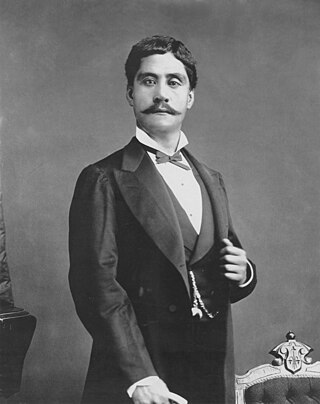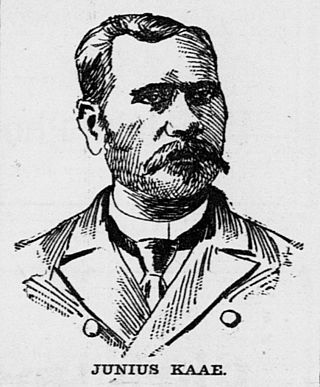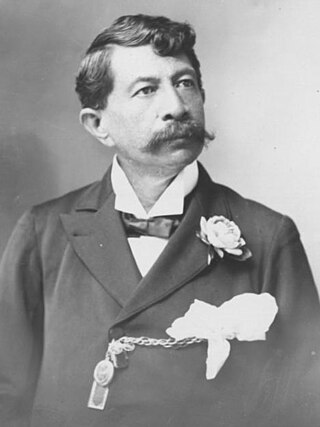Lydecker, Robert C. (1918). Rosters of Legislatures of Hawaii 1841–1918. The Honolulu Gazette Col., Ltd. p. 301.
Related Research Articles

Lunalilo was the sixth monarch of the Kingdom of Hawaii from his election on January 8, 1873, until his death a year later.

William Pitt Leleiohoku II, born Kalahoʻolewa, was a prince of the Hawaiian Kingdom and member of the reigning House of Kalākaua.

Luther Aholo was a politician who served many political posts in the Kingdom of Hawaii. He served multiple terms as a legislator from Maui and Minister of the Interior from 1886 to 1887. Considered one of the leading Hawaiian politicians of his generation, his skills as an orator were compared to those of the Ancient Greek statesman Solon.

Albert Kūkaʻilimoku Kūnuiākea was the illegitimate son of King Kamehameha III and his mistress Jane Lahilahi. He served as a politician in the Kingdom of Hawaii and the Republic of Hawaii. He later was baptized into the Anglican Church of Hawaii with the name Albert Fredrick Kunuiakea Oiwiaulani Koenaokalani.

J. W. Lonoaea was a politician of the Kingdom of Hawaiʻi who served in the House of Representatives of the Legislature of the Kingdom from 1872 until his death. Following the death of King Lunalilo, it fell to the legislature to choose the next monarch from amongst the native-born high chiefs, though only three candidates were considered seriously: Bernice Pauahi Bishop, David Kalākaua, and Queen Emma. Lonoaea voted with the majority in supporting Kalākaua, and was one of the thirteen legislators to be injured by supporters of Queen Emma in the ensuing 1874 Honolulu Courthouse riot. Lonoaea was the only legislator who did not survive his injuries.

Paul Nahaolelua was a Hawaiian high chief who served many political posts in the Kingdom of Hawaii, including Governor of Maui from 1852 to 1874. In his long political career, Nahaolelua served under the reigns of five monarchs: Kamehameha III, Kamehameha IV and Kamehameha V, Lunalilo and Kalākaua.
John Green Hoapili was a judge and politician of the Kingdom of Hawaii. He served as a legislator for many years. He commonly referred to by his initials, J. G. Hoapili.

Colonel Charles Hastings Judd was a Hawaiian businessman, rancher, courtier and politician who was born, lived, worked and died in the Kingdom of Hawaii. He served as chamberlain and colonel of the military staff of King Kalākaua and traveled with the monarch on his 1881 world tour.

David William Pua, also known as D. W. Pua, was a politician during the Kingdom of Hawaii. He served as a legislator during the last years of the Legislature of the Kingdom of Hawaii and became a member of the Hui Aloha ʻĀina, founded after the overthrow of the monarchy to protest attempts of annexation to the United States.

Junius Kaʻae was a Native Hawaiian politician of the Kingdom of Hawaii. In 1887, he was implicated in the infamous bribery scandal involving King Kalākaua over the sale of an opium license to Tong Kee.

Joseph Oliver Carter, known professionally as Joseph O. Carter, also known as J. O. Carter and Joe Carter, was a legal advisor to Queen Liliʻuokalani, serving on her Privy Council of State.

Godfrey Brown was Minister of Foreign Affairs under King Kalākaua and Minister of Finance and under both Kalākaua and Liliʻuokalani.

When King Kalākaua began his reign on February 12, 1874, the monarch was constitutionally empowered to appoint and remove the Kingdom of Hawaii cabinet ministers. The four cabinet positions were Attorney General, Ministrer of Finance, Minister of Foreign Affairs and Minister of the Interior. The royal cabinet ministers were also ex-officio members of the House of Nobles in the legislature and the Privy Council of State, a larger body of advisors.

Liliʻuokalani was the first queen regnant and the last sovereign monarch of the Kingdom of Hawaiʻi. The queen ascended to the throne on January 29, 1891, nine days after the death of her brother Kalākaua, and inherited his cabinet ministers. The four cabinet positions were Attorney General, Minister of Finance, Minister of Foreign Affairs and Minister of the Interior. The ministers were ex-officio members of the House of Nobles in the legislature and the Privy Council of State, a larger body of advisors.
Pius F. Koakanu was a Hawaiian high chief (aliʻi) from the island of Kauai who served as a politician during the Kingdom of Hawaii and the Kahu or Keeper of the Royal Mausoleum of Hawaii at Mauna ʻAla.

Following the January 20, 1891 death of King Kalākaua in San Francisco, his embalmed body arrived at Honolulu Harbor aboard the USS Charleston, draped in black with its ensigns at half mast. His sister Liliʻuokalani was designated his successor.

The Privy Council of State of the Kingdom of Hawaii was a constitutionally-created body purposed to advise and consent to acts made by the monarch. The cabinet ministers were ex-officio members. Both the cabinet and other privy counselors were appointed and dismissed by the monarch according to his personal wishes. The 1887 Constitution of the Kingdom of Hawaii made a key change in regards to the cabinet ministers. The monarch was still empowered to appoint the ministers, but only the legislature, or a voluntary resignation, could remove them from office.

John Ena Jr. was a Hawaiian business magnate and politician. He was an advisor to both King Kalākaua and Queen Liliʻuokalani. After the overthrow of the Hawaiian Kingdom, his advisory position was retained during the Provisional Government and the Republic of Hawaii. Ena Road in Waikiki is his namesake.

George Charles Mo'oheau Kauluheimalama Beckley was a member of Liliʻuokalani's Privy Council of State from 1891 to 1892, and a director of the Wilder Steamship Company. Born of Hawaiian and British ancestry, his native Hawaiian forebears were reputed to have helped hide the bones of Kamehameha I. Like his British grandfather who was an advisor to Kamehameha I, he chose a life sailing the seas. In his youth, he joined whaling expeditions and survived a hijacking spree by pirates who captured 29 ships. Beckley was one of 50 Hawaiian crew members who were rescued from multiple vessels and sent safely back to Hawaii. He found his life's career with Hawaii's inter-island steamships, where he partnered with Samuel G. Wilder. Beckley was awarded the Royal Order of the Star of Oceania and the Order of the Crown of Hawaii by King Kalākaua.

Edward Kamakau Lilikalani was a political protégé of King Kalākaua of Hawaiʻi. He served more than a decade in the lower house of the Legislature of the Hawaiian Kingdom, and after nearly two decades out of office, was elected to the same legislative body under the Territory of Hawaii. Lilikalani was a member of both Kalākaua's Privy Council of State and Liliʻuokalani's Privy Council of State. Kalākaua decorated him with the Royal Order of Oceania, Order of Oceania, Order of Kalakaua, and Order of Kapiolani.
References
- 1 2 "Godfrey Rhodes Departs". Evening Bulletin. September 8, 1897. p. 5, col. 2.
- ↑ "Hawaiian Coffee". Polynesian. March 3, 1849.; Kuykendall 1938 , p. 320
- 1 2 "Was Remembered". March 9, 1897. p. 1, cols. 4–5.
- ↑ Kuykendall 1938 , pp. 266–267
- ↑ "Godfrey Rhodes Office Record" (PDF). Hawaii State Archives Digital Collection.
- ↑ Lydecker 1918 , pp. 32, 107, 113
- ↑ Lydecker 1918 , pp. 139, 143, 156
- ↑ Lydecker 1918 , pp. 139, 156
- ↑ At the king's bedside at this moment were, on the right, Reverend J. Sanders Reed, Colonel Macfarlane, and Admiral Brown; on the left, Colonel Baker, Kalua, and Kahikina; at the foot of the bed, Mrs. Swan, Consul McKinley, and Dr. Woods; grouped around the room, Lieut. Dyer, Charles R. Bishop, Godfrey Rhodes, Judge Hart, Senator G. E. Whitney, Mrs. McKinley, Mrs. Price, Mrs. J. S. Reed, and Claus Spreckels. Kuykendall 1967 , pp. 472–473
- ↑ "Hon Godfrey Rhodes' Will". Evening Bulletin. September 24, 1897. p. 1, col. 5.
- ↑ Kuykendall 1967 , pp. 477, 510, 602
- ↑ "Late Godfrey Rhodes (funeral details)". The Pacific Commercial Advertiser. September 9, 1897. p. 6, col. 3.
Text is available under the CC BY-SA 4.0 license; additional terms may apply.
Images, videos and audio are available under their respective licenses.
Godfrey Rhodes | |
|---|---|
 Godfrey Rhodes and daughter | |
| Privy Council of the Hawaiian Kingdom |